#DocLab
Text
Videopraxisworkshop
Wohnungsfrage in Berlin
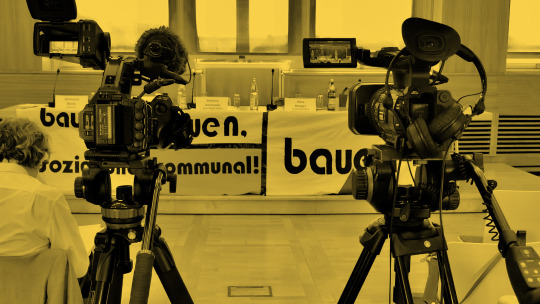
Bildungsangebot LETsDOK
Gemeinsam mit der Filmemacherin Tanja Brzaković biete ich einen Praxisworkshop zur Video- und Filmerstellung an. Im Zentrum steht die Wohnungsfrage in Berlin. Veranstaltet wird das Bildungsangebot von LETsDOK.
Wohnen ist ein Grundbedürfnis, gar ein Menschenrecht. Aber aufgrund historischer und sozioökonomischer Entwicklungen ist Wohnraum (nicht nur) in Berlin inzwischen meist knapp. Das Medium Film eignet sich, um dieses Alltägliche und seine Widersprüche herauszuarbeiten und darzustellen. Dieser Praxisworkshop lädt Betroffene, AktivistInnen und an sozialen Entwicklungen Interessierte dazu ein. Filmkenntnisse werden nicht vorausgesetzt, können aber ggf. in die Gruppe eingebracht werden. Nach einer Einführung in unterschiedliche Filmformen und Grundlagen der Filmsprache, einschließlich Tipps zur Kameraführung und Tonaufnahmen und Postproduktion, arbeiten einzelne Teams an Filmen, die öffentlich präsentiert werden.
Tanja Brzaković wurde in Belgrad, Serbien, geboren und lebt seit 2003 in Berlin. Sie schreibt und führt Regie bei Kurz- und Dokumentarfilmen sowie Videokunst. Seit 2004 engagiert sie sich intensiv in der medienpädagogischen Arbeit mit Jugendlichen und Hochschulstudenten.
Der Filmemacher, Fotograf und Soziologe Matthias Coers ist Bildredakteur beim Berliner MieterEcho, der Zeitung der Berliner MieterGemeinschaft. Dokumentarfilme über Stadtentwicklungsthemen, u.a. Mietrebellen (Co- Regie Gertrud Schulte Westberg), Das Gegenteil von Grau und Dystopolie.
Ort:
Aquarium, Skalitzer Str. 6, 10999 Berlin Die Workshopteilnahme ist kostenlos. Anmeldung: [email protected]
Termine:
10.9.2023 10:00-17:00
Thematische, filmtheoretische und praktische Einführung, Besprechung der weiteren Arbeit und Teambildung
16.9.-17.9.2023, 10:00-17:00 (oder nach Bedarf/online)
Arbeit an Filmen mit Betreuung
Es besteht auch die Möglichkeit, einzelne DocLab-Workshops zu besuchen, um Kenntnisse in einzelnen Feldern wie Ton, Licht, Montage o.a. zu vertiefen. pro Workshop € 10,-
24.9.2023, 17:00
Öffentliche Präsentation der im Workshop entstandenen Filme


0 notes
Text
0 notes
Text
Coffee, Caniba, and cannabis
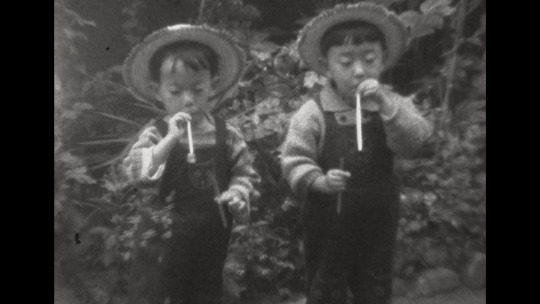
After his 2015 visit, Greg de Cuir, Jr returns to IDFA for yet another round of discoveries – again in the edgy opulence of Paradocs' line-up, as well as around the new espresso machine in the festival lounge...
Maybe it is a mistake to venture into a festival as immense as IDFA without browsing the various selections in advance. At a certain point, information overload and work overload take their toll. Then again, for some festivals it is better to dive right in and throw yourself at the mercy of the curatorial gods. Though sprawling, IDFA is a festival with a clean and precise profile: competition for features, competition for mid-lengths, national competition, new media competition, festival favorites, masters, themed programs, et al.
A nd then there is Paradocs, the unsung section that captured my attention on my last visit to the festival two years ago, and which is closest to my sensibilities and areas of professional engagement. The first thing I did – after picking up my accreditation, after helping myself to the complimentary espresso machine in the guest lounge, and after helping myself to one more perfectly automated macchiato – was to look for the Paradocs listings as I quickly scanned the catalog. Most people look for coffee shops when they visit Amsterdam. I just look for the coffee.
Paradocs is the home for documentary work that sits on a number of borders, for example with fiction, or with the fine arts. In short, this is where one would look for more risky and creative works that flaunt classical codes and rules of documentary engagement. Unfortunately, it seemed that the section was more modest in scope than I remember two years ago. Or was it the coffee? Fourteen results show up on the festival search page – a relatively even mixture of lengths, with some titles cross-listed in one competition or another. If only Paradocs was afforded the care and expanse of the new-media-focused DocLab, with an exhibition, a conference, performances, and related endeavors. For now, that is just a somniloquy.
Still, I was happy to discover the film CANIBA (2017) on the Paradocs slate – even happier to see it was playing on my first day at IDFA. It became an immediate priority on my non-existent agenda. After premiering in Venice, making the rounds in Toronto and New York, CANIBA returned to the continent via Amsterdam. I have been following the work of the co-directors Véréna Paravel and Lucien Castaing-Taylor with interest – beginning with LEVIATHAN (2012), which struck me as a solid film that was ultimately a bit overrated, and continuing with SOMNILOQUIES (2017), which was totally uninteresting. The artists’ affiliation with the famous Sensory Ethnography Lab at Harvard University adds a certain promise to their work – not of an academic affair but of something interdisciplinary, of something experimental, something beyond the status quo of contemporary non-fiction.
CANIBA looks awfully close to a masterpiece. The tightly-framed and textured imagery developed in SOMNILOQUIES is here given an extra emotional charge and clarity by the weight of the subject matter: the notorious Japanese cannibal Issei Sagawa and his brother Jun. The flirtation with death and a nightmarish existence that was explored in LEVIATHAN is made even more palpable here, through both cinematic means and also through the incomprehensible nature and activities of the subjects. The sensory part of the equation is on full display in CANIBA. It is an affective, tactile experience that reaches out from the screen and touches the viewer. I immediately knew that I would not see a better documentary during the rest of my time at the festival, and I was right.
We finally exit the confines of the two brothers’ home at the conclusion of the documentary. Thrust into the sunlight, pushed in a wheelchair, with the odd sounds of a rapturous ovation mixed with birds singing, Issei repeats the words “It’s a miracle” over and over again. The question of whether this deranged killer deserves one is another matter, but force majeure is indiscriminate. This joie de vivre that he feels, this horizon of possibilities, is a gift that is transferred to the audience. I can think of no better justification for the sensory impulse in ethnography, or for the laboratory that the Paradocs program could and possibly should be.
If you a film industry professional, you can watch titles from IDFA on Festival Scope
#IDFA#IDFA2017#Paradocs#DocLab#La Biennale#Venice Orizzonti#TIFF#Wavelength#New York Film Festival#NYFF55#Amsterdam#daily life#documentary cinema#new media#Leviathan#Somniloquies#Caniba#Véréna Paravel#Lucien Castaing-Taylor#Sensory Ethnography Lab#Harvard University#Issei Sagawa#cannibalism#essay#Greg de Cuir Jr
2 notes
·
View notes
Photo

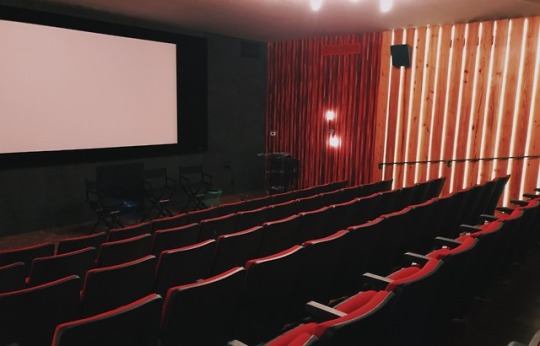
THE LAST OUT
Thrilled and honored to be part of the IFP Doc Lab. Thanks IFP!
https://www.ifp.org/press/ifp-doc-labs-2019/#.XO2J8pNKjyg
0 notes
Text
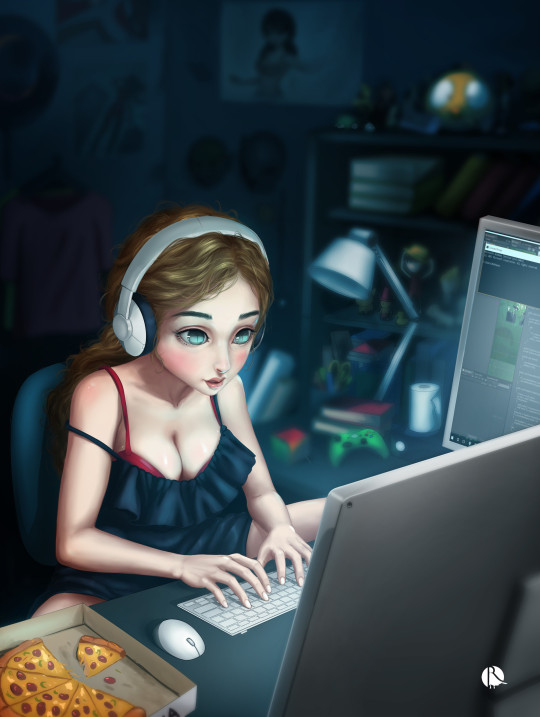
242Quest x Doclab Short Film Competition
0 notes
Text
Nixon deepfaked to read his prepared speech for a moon-landing disaster

Rob Beschizza:
President Richard Nixon had the honor of welcoming Earthlings to the moon, but speechwriter William Safire had prepared an alternative for use in the event of a moon-landing disaster. A team at MIT deepfaked the dead president into this alternative timeline.
In Event of Moon Disaster will premiere at IDFA DocLab on November 22, 2019 in the form of a physical installation designed to re-create a 1960s era American living room.
This project is a production of the MIT Center for Advanced Virtuality.
I've been trying to make this exact artifact for months, without success! Making people do things they didn't is much harder than the usual generative fare: the voice, physical consistency, the emotions, and the historical details all conspire to subvert the "easy" part of making someone's chops move. A lie is harder than a joke, which is why lies are posed as jokes. The achieved result, though, is magical and disquieting -- look how they make Nixon choke up! And a warning.
https://boingboing.net/2019/11/25/nixon-deepfaked-to-read-his-pr.html
25 notes
·
View notes
Photo



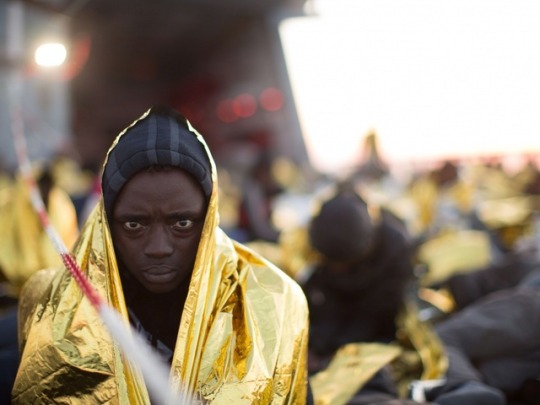



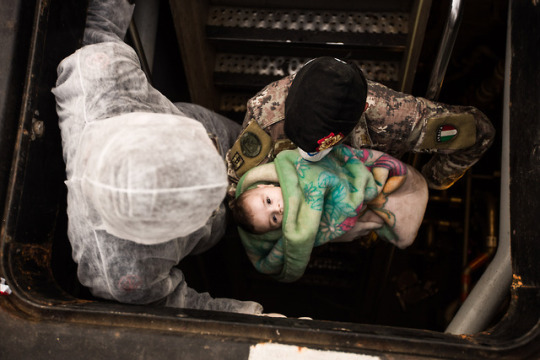


La marina italiana salva i richiedenti asilo che viaggiano in barca al largo della costa africana nel Mediterraneo. Massimo Sestini-Polaris Volti stravolti, un minuscolo piede che sbuca da una coperta, un Corano, frammenti di speranza e terrore in un barcone … Era il 2014 e il fotoreporter Massimo Sestini seguiva le operazioni di salvataggio "Mare Nostrum", al largo delle coste libiche. Dopo dodici giorni di tempesta, dall'elicottero il fotografo inquadra un barcone di migranti tratti in salvo. Lo scatto foto vince la sezione “General News” del World Press Photo nel 2015. E ci racconta in forma nitida la speranza nell’Europa, nell’Italia, la paura di chi ha rischiato di finire sul fondo del Mediterraneo quando il nostro Paese, la sua politica al vertice e molti dei suoi cittadini, vedevano nel salvare vite umane un gesto di umanità doveroso e nel respingere o rifiutare chi tenta la traversata un atto inumano oltre che politicamente ingiusto e, alla lunga, dagli effetti devastanti. La foto sui migranti in salvo si può vedere accanto ad altre immagini di Sestini in due luoghi diversi: riprodotta in un luogo inconsueto per uno scatto, il Nelson Mandela Forum di Firenze, nella mostra permanente “Mediterraneum - il diritto alla speranza, scatti dal mare”, e inserita nell’esposizione del fotografo “L’aria del tempo” in corso fino al 10 marzo nello storico edificio di architettura razionalista Wegil a Roma. E sono esposte con un accorgimento: al soffitto, per cui chi guarda ha il punto di vista di chi sta in basso, non in alto. Le immagini richiamano anche l’impegno che i governi del mondo si sono presi nel 1979 firmando la Convenzione Internazionale sulla Ricerca e il Salvataggio Marittimo, che fra le altre cose recita: “Le parti garantiscono che l’assistenza sia fornita a qualsiasi persona in difficoltà in mare. Lo faranno indipendentemente dalla nazionalità o dallo stato di tale persona o dalle circostanze in cui tale persona è stata trovata”. “Grazie a un appello lanciato in rete, Massimo Sestini ha rintracciato alcune persone immortalate in quegli scatti: qualcuno vive in Italia, altri sono all’estero, di molti si sono perse le tracce – informa la nota stampa - . Un documentario per National Geographic Channel è in preparazione presso la casa di produzione DocLab. Il 20 giugno, in occasione della Giornata Mondiale del Rifugiato, il documentario andrà in onda in tutto il mondo, su oltre cento canali tv del network National Geographic”. (Globalist+Time+altri)
39 notes
·
View notes
Video
vimeo
Die With Me - The chatapp you can only use when you have less then 5% battery
Die With Me is an chat app you can only use when you have less than 5% battery.
Enter the chatroom full of people with a low battery.
Die together in a chatroom on your way to offline peace. #diewithme.
App by Dries Depoorter and David Surprenant
Presented in collaboration with IDFA Doclab
http://www.doclab.org
The app is available for iOS and Android.
http://www.diewithme.online
Dries Depoorter lives in Belgium as artist working with technology and works also as a freelance concept provider. He is interested in privacy, surveillance and social media.
http://www.driesdepoorter.be
David Surprenant lives in Montreal as a freelance interactive developer. It's main projects are more focused on public interaction and especially with web technology.
http://www.davidsurprenant.com
Director of Photography: Bieke Depoorter/Magnum Photos
Girl: Stephanie Beckaert Editors: Bieke Depoorter/Magnum Photos & Dries Depoorter
Music: Benny Martin Piano - Drake - Hold on We're going home (piano instrumental cover)
0 notes
Text
CAVEMAN IL GIGANTE NASCOSTO
CAVEMAN IL GIGANTE NASCOSTO
DocLab, in collaborazione con Valmyn, è lieta di distribuire nei cinema italiani CAVEMAN – Il gigante nascosto, diretto dal regista Tommaso Landucci. Dopo aver avuto ricevuto il plauso di pubblico e critica all’ultima Mostra Internazionale d’arte cinematografica di Venezia, Giornate degli Autori, ed essere stato in selezione ufficiale al Festival dei Popoli, il film dedicato all’artista Filippo…

View On WordPress
0 notes
Photo

I have recently collaborated with a dermatologist to deliver a talk about ageing skin care. One of the most important tip is application of sun protection even when indoors. . Sun protection tips -Broad-spectrum, water-resistant sunscreen > SPF 30 or higher every day -All sun exposed areas -15- 30 minutes before -reapplied every 2 hours -more often if swimming, sweating, or towelling -Seek shade when outdoors . Doclab Professional Series: UV Light Sun Protector is an excellent choice with SPF50+ PA++++, offers broad spectrum UV protection. It is also lightweight and does not burden the skin or cause breakout. I also use it as tone-up base with anti-ageing ingredients to boost skin radiance. . Check out @doclabkorea_official for more great skincare products which are medical grade— don’t forget the discount code ruvslight30 . . . . . . #yingzangel #sunscreen #skincare #spf #sunblock #skincareroutine #serum #beauty #moisturizer #jerawat #cleanser #sunprotection #antiaging #skin #healthyskin #skincareproducts (at Teluk Cempedak,Kuantan) https://www.instagram.com/p/CUyhV5JhGZr/?utm_medium=tumblr
#yingzangel#sunscreen#skincare#spf#sunblock#skincareroutine#serum#beauty#moisturizer#jerawat#cleanser#sunprotection#antiaging#skin#healthyskin#skincareproducts
0 notes
Photo

From sailing a paper boat across your smartphone screen, to assessing your biases, the free digital projects from Very Very Short push the possibilities of mobile interaction. The 10 web-based projects were made by an international group of creators chosen from an open call put out by the National Film Board of Canada (NFB) and ARTE, in collaboration with the IDFA DocLab.
(via 60-Second Digital Projects Push the Possibilities of Mobile Interactivity)
12 notes
·
View notes
Text
Documentary programme-making (supported by Netflix)
Documentary programme-making (supported by Netflix)
The Grierson Trust offers schemes to people who are interested in factual and documentary programme-making. It is offering people aged 18+ to take part in its three curated schemes, which are all supported by Netflix. The application deadline is 12th February at 5pm. https://griersontrust.org/outreach/grierson-doclab-2021/
Applications for Grierson DocLab 2021 are now open!
About the…

View On WordPress
0 notes
Link
<< So what is Sylvia?
She’s a hybrid. Her visual side is designed the way all other virtual influencers are, using Daz 3D and assets from that 3D modified with ZBrush, and garments rendered by Marvelous Designer—the whole process is the same. Her writing is partially generated, so every other image has computer-generated text that’s modeled on influencer writing—to progress the story in a way that makes sense, it’s my writing [that’s] actually portraying her, but when she’s looking at the world, the way she talks about it is computer-generated, essentially. [For that] we created a language model tweaked by the language of influencers, in general, that we collected. We scraped their texts and then created this [algorithm] that can write like an influencer, essentially. But it’s also curated, in the sense that I generate a lot of different texts and then I select the one I’m going to use. But that’s how a lot of the generative stuff is being done these days. >>
0 notes
Text
New top story from Time: ‘We Want to Help the World Better Understand China.’ Meet Chen Xiaoqing, the Film Director Using Food to Make Friends
The humblest food becomes wondrously photogenic in the films of Chen Xiaoqing, creator of the hit Netflix series Flavorful Origins and its progenitor Once Upon a Bite. Dumplings are crafted on timber boards amid billows of flour. Steam shrouds mottled crabs, cooking with ginger and chili in in tall stacks of wicker baskets. Fishermen wade into crashing surf on wooden stilts to snare sardines with A-frame nets. There are aerial shots of emerald rice terraces, time-lapse sequences of drying bricks of tea, and mortar-eye views of pestle-pounded spices.
There’s not a fast-food restaurant or production line in sight in this romanticized glimpse of a homespun culinary culture sadly threatened by industrial kitchens, agribusiness and progress.
“Our food must be delicious, beautiful, with a legacy and connection to local culture and geography,” Chen tells TIME in his Beijing office. “For the people, they must really love the food, put in their labor and have a deep connection with it.”
Chen, 55, originally from China’s eastern Anhui province, has charged himself with keeping many of his homeland’s food traditions alive. Over the past three decades, the world’s most populous nation has become the world’s number two economy and home to the planet’s largest middle class. In the rush to sate 1.4 billion bellies, corners were cut and standards plummeted, leading to a slew of food safety scandals. Today, though, the impetus has shifted from quantity toward quality natural produce. “People are leaning towards healthier options, not just vegetables, but wanting to know their food is processed with care,” says Shanghai-based food blogger Rachel Gouk.
It’s a trend epitomized by the critically acclaimed Flavorful Origins, a series of short films and the first original Chinese documentary to be bought by Netflix. Chefs chosen for inclusion in Chen’s work can see demand for signature dishes soar hundred-fold overnight. The first series spotlighted the coastal cuisine of Guangdong’s Chaoshan region, with the second focusing on the fresh, fragrant spices of southwestern Yunnan province, which draws much influence from neighboring Laos and Myanmar.
The third season, set in China’s central Gansu province, debuts on Netflix next month. Gansu is a thin strip of territory stretching more than a thousand kilometers from dunes in the north to lush mountains in the south. It also boasts a significant Muslim minority. “So they have really different types of food that reflect the local terrain and [cultures],” says the filmmaker.
Chen has given himself an additional brief at a time of historic tensions between the U.S. and China. The superpowers may be embroiled in a trade war, accusations of spying and IP theft, the sanctioning of officials over the detention of one million Uighur Muslims in China’s far west, and the origins of the COVID-19 pandemic—but Chen hopes that food can help soften his country’s image. “Through beautiful food we want to help the world better understand China and the Chinese people,” he says.

DOClabs Beijing In this still taken from Season 2 of the series Once Upon a Bite, which debuted on Apr. 26, 2020, a dish known as multiple-layer oil cake is seen on a table in Yangzhou, China.
Chinese food in the U.S.
The U.S. love affair with Chinese cuisine is long and complex. In fact, one of the most American staples, ketchup, is actually Chinese in origin. The name ketchup derives from the Hokkien Chinese kê-tsiap, referring to a fermented fish-based sauce that became popular with colonial Britons as far back as the 18th century.
When the first Chinese immigrants arrived in American in the mid-19th century, xenophobic ditties made reference to their unfamiliar eating habits. But in New York City, Chinatown flanked the Jewish Lower East Side, and the Jewish community became early adopters of the new cuisine. By 1899, the enduring tradition of Jews eating in Chinese restaurants at Christmas had already been documented. In the early 20th century, the Boston Globe was telling readers to consider Chinese themes for their wedding banquets, while the Chicago Tribune declared Chinese restaurants the perfect place to woo a girl on a first date.
“Chinatowns, which had been framed as dens of iniquity, became the first counterculture cool among the American cognoscenti, and then became mainstream,” says John Pomfret, a former Beijing bureau chief for the Washington Post and author of The Beautiful Country and the Middle Kingdom: America and China, 1776 to the Present.
When a devastating earthquake flattened San Francisco in 1906, that city’s Chinatown was prioritized for reconstruction because of the tourist dollars it brought in. By 1919, the American Chemical Society was advising that Chinese food was good for health. A decade later, nearly a third of American counties had at least one Chinese resident, many of whom opened restaurants. “The Chinese became the most dispersed ethnic group in the country,” says Pomfret. Today, there are more Chinese restaurants in the U.S. than McDonalds and KFC outlets combined.
Read more: The Untold Story of the World’s First Michelin Three-Star Chinese Restaurant
The question is whether food can still build bridges today. A Pew Research Center survey published in July found 73% of American adults had a negative view of China, the highest since the question was first asked 15 years ago. Verbal attacks and assaults on Asian Americans have soared since the coronavirus took hold. At the recent presidential debate, Donald Trump again sought to assign blame for the pandemic, saying “It’s China’s fault.”
For Chen, however, there are more commonalities than differences. He points out that around 10,000 years ago people across the world began cultivating wheat. In the West, they used it to bake bread; in the East, they steamed buns. “People may focus on the difference between East and West as being like fire or water,” says Chen. “But in terms of food—bread or buns—it’s not that drastic.”
Not all of China’s culinary culture meets with acceptance. The consumption of rare, wild species for their purported health benefits has long been of concern. The 2002 to 2003 SARS pandemic was eventually traced to civet cats sold for consumption at a market in China’s southern Guangdong province, and a leading—though unproven—hypothesis is that there is a similar provenance for coronavirus, which first came to light in a market in the central city of Wuhan.
Chen says he is “very concerned” about the protection of wildlife, never features endangered creatures in his programs and even puts health disclaimers on scenes that feature raw shellfish.
“In truth, most Chinese people eat a limited selection of food,” he says. “They don’t even eat steak rare because they think it’s unhygienic. They have to cook everything. The sample of the coronavirus found in the market has nothing to do with food; it has to do with the modernization of the entire country. If we can ventilate and make our markets more sanitary, such problems can be solved.”
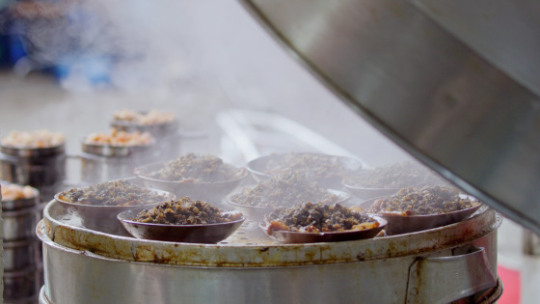
DOClabs Beijing In this still taken from Season 2 of the series Once Upon a Bite, which debuted on Apr. 26, 2020, dishes of braised pork rice from Sichuan, China are being steamed.
Chinese cuisine and national identity
In some ways, Chen is riding a wave of national interest in a sentimentalized past—a craze known as fugu. Increasingly, Chinese millennials are donning hanfu robes that date from the Tang Dynasty, playing bamboo flutes and quaffing Osmanthus wine in order to reconnect with their cultural heritage. One father in Sichuan province recently dispensed with the family car and decided to take his son to kindergarten on a bull. He said that while using this archaic form of transport, he would “explain ancient poems and traditional culture” to the youngster. For a rapidly urbanizing society, increasingly disillusioned by a hyper-commercialized race to riches, such affectations prove alluring.
Some academics frame this cultural revival in terms of a restored national pride. It could be seen as “embarrassing that Chinese people attend social functions or major international occasions dressed in suits, ties, and leather shoes, which not only fail to represent their homeland, but also imitate the garb worn by the erstwhile outsiders who once brought China to its knees,” writes Yang Chunmei, a professor of Chinese history and philosophy at Qufu Normal University.
China’s strongman president, Xi Jinping, has certainly made many calls for the preservation of Chinese tradition while decrying the influence of “Western values”—even if much that tradition is awkwardly rooted in Imperial feudalism and at clear odds with the Marxist doctrine that the Chinese Communist Party is committed to upholding.
Read more: A Very Brief History of Chinese Food in America
In this context, Chen’s work coalesces national identity at home even as it seeks to break down barriers abroad. He has set his eyes beyond China, citing Lebanon as his dream destination (“It’s got European influence, Arab influence, that’s very interesting”). He became enamored with the Middle East while filming in Jerusalem.
“We saw that Jews, Arabs, Christians have different religions and cultures,” Chen says, “but they all appreciate the same food.”
Given the intolerance that roils the Middle East, it’s a bit of a stretch to posit some sort of regional amity based on a shared love of olives and flatbread, but Chen is undeterred.
“There are constantly quarrels and tensions, not only between China and America, but between all different cultures,” he says. “The best way to solve them is communication—and people always talk over food.”
—Video by Zhang Chi/Beijing
via https://cutslicedanddiced.wordpress.com/2018/01/24/how-to-prevent-food-from-going-to-waste
0 notes
Text

Ok phong cách giống các phim độc lập bên Doclab. Nó là một hướng đi riêng đi, một phong cách hay trường phái. giống như một thằng làm truyền hình đã 4 năm nhưng buổi tối bật tivi lên không biết mình đang xem cái gì. Cái thứ âm nhạc bọn nhóc nghe hiện tại còn không giống nhạc. Và cũng đến lúc điện ảnh - cũng không có hình luôn.
0 notes
Photo
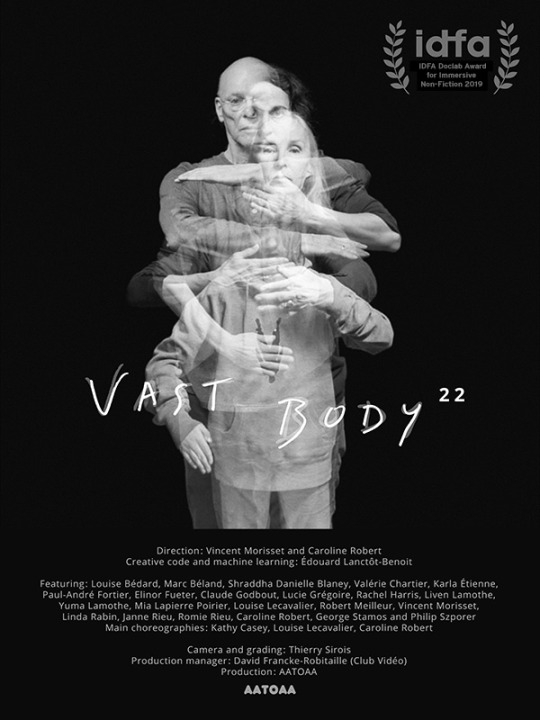
Vast Body
" To move, to dance, to flow, to see ourselves, but most of all, to see others. Finding empathy in a digital mirror, playful and embodied, becoming one with so many. We sometimes forget to do so in our selfie times, but it is exactly that which we need to re-establish and to become team human again. Honest and full of joy, this project shows us how. The creator, the dancers, and you make the tech disappear." IDFA Doclab Award for Immersive Non-Fiction
vimeo
Vast Body is an award winning interactive installation and an ongoing collaborative experiment on movement directed by Vincent Morisset and Caroline Robert, produced by studio AATOAA. In the installation a myriad of alter egos continuously try to replicate the movements of the person facing it, while interpreting its behavior. Via a kind of a magic mirror, the physical body is connected with a digital incarnation giving the chance to inhabit in another body for a while through movement. The software perceives and understands a wide spectrum of human postures and then it distills the continually changing input into a projection of a body that moves fluidly, yet fluctuates continuously between different bodies and identities.
This installation draws on timely questions of empathy, identity and our relationship with artificial intelligence.
Source
0 notes